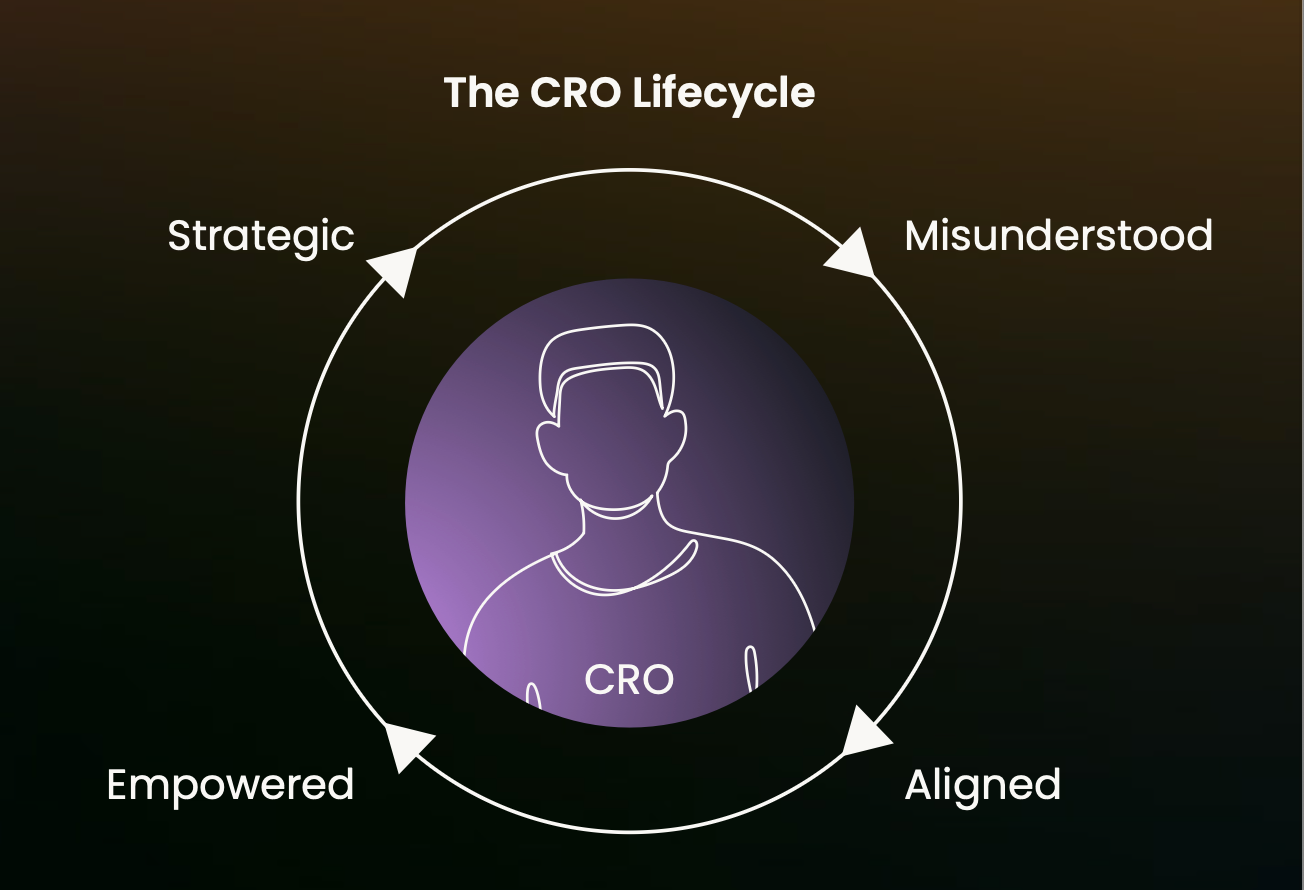CROs are caught in a paradox. The role is one of the most powerful seats in the C-suite – yet it’s also the most vulnerable. Average tenure? Less than 18 months. Expectations? Deliver immediate revenue results, orchestrate cross-functional teams, and future-proof the business.
No pressure, right?
But there’s one lever that makes or breaks every CRO’s impact: alignment. Not just a buzzword or a quarterly strategy slide – alignment is the operational backbone that separates thriving CROs from those watching the exit door
In our research for the CRO Insights Report, we dug deep into how 30+ chief revenue officers are bridging these divides, and how alignment is turning from a buzzword into a full-blown operating system.
Here’s what you need to know.
Why alignment is the ultimate CRO lever
Alignment isn’t just another initiative to tick off. It’s the lever that keeps teams working in the same direction, driving towards the same goals, and help CROs reach their full potential.
To foster true alignment, CROs need to prioritize shared goals, KPIs, and consistent planning rituals across teams. When teams from sales, marketing, and customer success all measure their performance against the same goals, it drives collaboration and encourages mutual accountability.
It's not just about hitting numbers, it’s about creating a unified revenue engine that moves forward together, not in silos.
Equally important to alignment is operational cadence. Successful CROs build regular rhythms of communication, where teams share updates, troubleshoot issues, and align strategies. These regular touchpoints help keep all departments in sync, ensuring that goals aren't just communicated but actively pursued with a shared sense of purpose.
Perhaps most importantly, alignment means having a shared understanding of the customer journey. By placing the customer at the center, CROs create a natural focal point for unifying teams.
This shared vision across the revenue engine – from awareness through to post-sales – ensures that everyone is working towards a seamless experience that adds value at every stage.
So how do our CROs actually do this in practice?

The four dimensions of alignment CROs must master
1. Alignment across revenue teams
60% of CROs we spoke to for our recent CRO Insights Report prioritized shared goals, KPIs, and planning rituals across teams to ensure alignment. It’s about more than the odd review. It’s about creating a shared language across Sales, Marketing, CS, and RevOps.
Sara Rasmussen, CRO at Telness Tech, puts it like this:

That North Star aligns metrics, sure, but also behavior, incentives, and culture. It kills the old blame games between Sales and Marketing, or between CS and Product, ensuring everyone’s progress is measured by the same yardstick.
2. Alignment with the CEO and C-Suite
Without CEO buy-in, a CRO is just another sales leader with a fancy title. Yet 40% of CROs report misalignment with their CEO on the scope of their role and the revenue strategy itself.
Warren Zenna, Founder of the CRO Collective, nailed it when he told us:

Fix this early:
- Is the CRO owning the entire revenue engine or just Sales?
- Is the CRO expected to drive strategy or execute someone else’s?
- Are we aligned on short-term targets vs. long-term growth bets?
If the answers are muddy, expect strategy drift, micromanagement, and a short tenure.

3. Alignment around the customer journey
High-impact CROs map the full customer journey as their blueprint for revenue alignment. From first touch to renewal and expansion, each team understands their role in the customer experience, and how that experience drives revenue.
Tony Aurigemma, CRO at Anomali, frames this well:

The result? A revenue engine where handoffs are seamless, data flows cleanly, and every team knows how their work contributes to growth.
4. Cultural alignment: Trust, transparency, and shared purpose
Alignment isn’t established through metrics and meetings alone. It’s human. Trust, transparency, and shared purpose are therefore the true fundamentals to a revenue engine that runs smoothly.
As one CRO put it:
“Alignment isn’t a memo – it’s a movement.”
That movement is built through open communication cadences, cross-functional collaboration rituals, clarity on the ‘Why’ behind strategy shifts, and the psychological safety to challenge, question, and improve.
These aren’t just soft skills, either. For CROs who want to thrive, they’re operational necessities.

How CROs can operationalize alignment
Alignment doesn’t happen by accident, it’s built into the fabric of how the organization operates. It requires systems, rhythms, and frameworks. Here’s how leading CROs embed alignment into their day-to-day:
- Shared KPIs: Define metrics that unite teams, rather than dividing them. For example, revenue retention, net new revenue, and customer advocacy rates.
- Regular rituals: Weekly syncs, bi-weekly risk reviews, monthly voice-of-the-customer sessions... Nicholas Ghitti, CRO at Native Teams, recommends defined SLAs per team and repeat rituals to build engagement.
- Strategic segmentation: Divide initiatives into short-term performance and long-term strategic bets. Naomi Brezi, CRO at Ruffalo Noel Levitz, runs dual operating rhythms to separate these lanes.
- Momentum mapping: Peter R. Platten, CRO at Protos Security, creates “momentum maps” aligned to five- and ten-year growth roadmaps, integrating product strategy, market expansion, and retention into a single growth view.
Alignment becomes real not in strategy documents, but in the cadence of meetings, the KPIs on dashboards, and the conversations happening across leadership and teams.
What alignment looks like in practice
Every CRO sits somewhere on this CRO lifecycle:

Misunderstood: CRO is seen as a VP of Sales. No alignment.
Strategic: CRO owns revenue strategy but lacks structural support.
Aligned: Teams and C-Suite share goals, but cadence is ad hoc.
Empowered: Alignment is built into daily operating rhythms, data flows seamlessly, and the CEO/CRO partnership is a true co-leadership.
The goal? Get to ‘Empowered’ as soon as possible, because that’s where impact becomes inevitable.
Conclusion
For CROs, the biggest lever isn’t a new tool, tech stack, or playbook. It’s alignment.
Master alignment across teams, up to the C-Suite, and through the customer journey, and you’ll not only extend your tenure, you’ll redefine what the CRO role can achieve.
Without it, even the sharpest strategy falls flat.
Play the long game. Pull the alignment lever first.
In the next article in this series, we’ll explore how CROs can future-proof themselves in 2025 and beyond. From the skills to master to the mindsets that sustain long-term success. Stay tuned.



 6 min read
6 min read
 Follow us on LinkedIn
Follow us on LinkedIn





